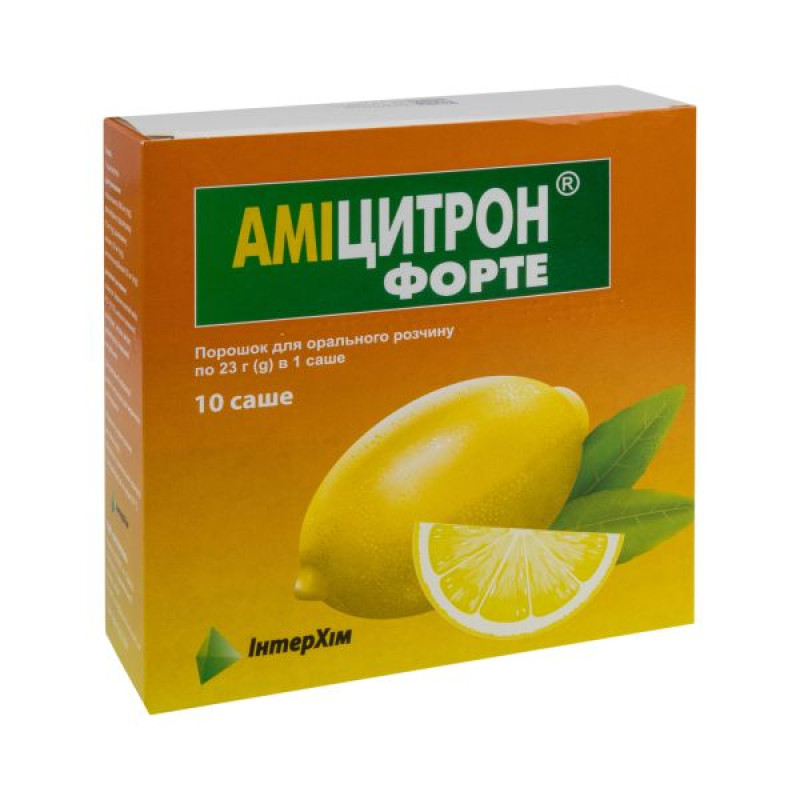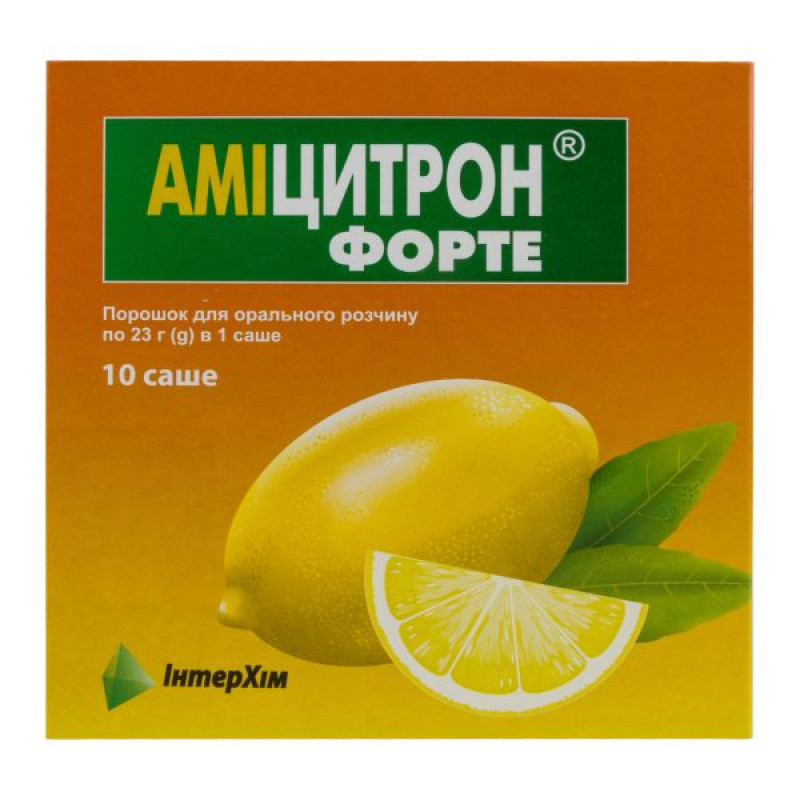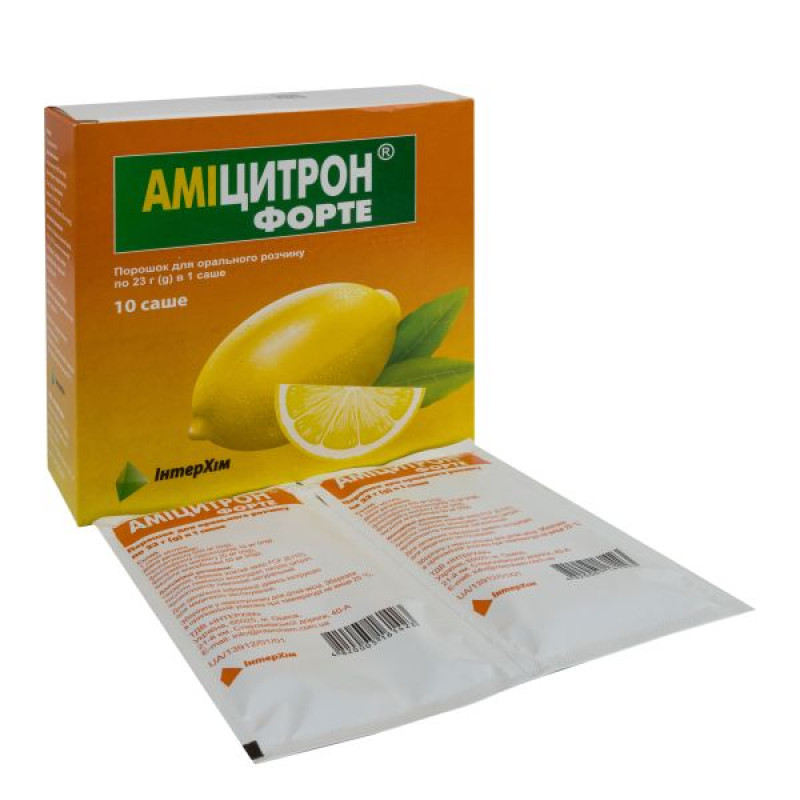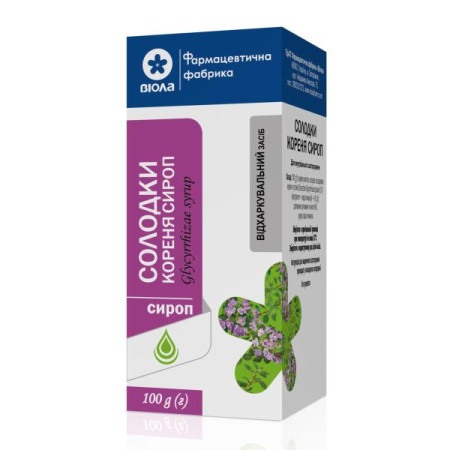Amicitron Forte powder for oral solution sachet 23 g No. 10

Instructions Amicitron Forte powder for oral solution sachet 23 g No. 10
Composition
active ingredients: paracetamol, phenylephrine hydrochloride, pheniramine maleate, ascorbic acid;
1 sachet contains paracetamol 650 mg, phenylephrine hydrochloride 10 mg, pheniramine maleate 20 mg, ascorbic acid 50 mg;
excipients: sucrose, sunset yellow FCF dye (E 110), citric acid monohydrate, sodium citrate, natural lemon flavor.
Dosage form
Powder for oral solution.
Main physicochemical properties: white powder, in which inclusions of pale yellow and/or orange are allowed.
Pharmacotherapeutic group
Analgesics. Other analgesics and antipyretics. Anilides. Paracetamol, combinations without psycholeptics.
ATX code N02B E51.
Pharmacological properties
Pharmacodynamics.
Paracetamol has antipyretic, analgesic and mild anti-inflammatory effects. Paracetamol inhibits the synthesis of prostaglandins in the central nervous system (CNS) and blocks the conduction of pain impulses.
Phenylephrine is an α-adrenomimetic, has a vasoconstrictor effect, reduces swelling of the nasal mucosa and paranasal sinuses.
Pheniramine is a histamine H1 receptor blocker that reduces vascular permeability, eliminates tearing, and itching of the eyes and nose.
Ascorbic acid enhances the body's nonspecific resistance.
Pharmacokinetics.
Paracetamol is well absorbed from the gastrointestinal tract, penetrates the placental barrier, penetrates to a small extent into breast milk, is metabolized in the liver by the cytochrome P450 system, is excreted by the kidneys, the half-life is 1–4 hours. The duration of action is 3–4 hours.
Phenylephrine is metabolized in the intestines and liver and excreted by the kidneys.
Pheniramine is well absorbed from the gastrointestinal tract, metabolized in the liver by the cytochrome P450 system, the half-life is 16–18 hours, 70–83% is excreted by the kidneys.
Ascorbic acid is rapidly absorbed from the gastrointestinal tract, metabolized in the liver, and excreted by the kidneys.
Indication
Symptomatic treatment of acute respiratory infections and influenza: fever, headache, nasal congestion, runny nose, pain and muscle aches.
Contraindication
Hypersensitivity to the active substances or to any of the components of the drug, pyloroduodenal obstruction, acute pancreatitis, severe liver and/or kidney dysfunction, congenital hyperbilirubinemia, glucose-6-phosphate dehydrogenase deficiency, phenylketonuria, diabetes mellitus, hyperthyroidism, prostatic hypertrophy with urinary retention, pheochromocytoma, bladder neck obstruction, severe forms of arrhythmia, arterial hypertension, atherosclerosis, ischemic heart disease; blood diseases, leukopenia, anemia, thrombosis, thrombophlebitis, bronchial asthma, angle-closure glaucoma, epilepsy, alcoholism, states of increased excitement, sleep disorders, concomitant treatment with β-blockers, other sympathomimetics, treatment with drugs that suppress or increase appetite, and amphetamine-like psychostimulants, tricyclic antidepressants, monoamine oxidase inhibitors (MAO) and the period within 2 weeks after stopping their use.
Interaction with other medicinal products and other types of interactions
The rate of absorption of paracetamol may increase when used with metoclopramide and domperidone and decrease when used with cholestyramine (this effect is insignificant if cholestyramine is used 1 hour later). Barbiturates reduce the antipyretic effect of paracetamol. When taking probenecid, the dose of paracetamol should be reduced, because it affects the metabolism of paracetamol. Paracetamol reduces the effectiveness of diuretics; may prolong the half-life of chloramphenicol; may induce the metabolism of lamotrigine in the liver, which reduces its bioavailability and effectiveness. Paracetamol may affect the results of determining uric acid levels by the phosphorotungstic acid method.
The interaction of phenylephrine with MAO inhibitors causes a hypertensive effect, with tricyclic antidepressants (including amitriptyline) increases the risk of side effects from the cardiovascular system, with cardiac glycosides (including digoxin) leads to arrhythmias and heart attack, with other sympathomimetics increases the risk of side effects from the cardiovascular system (including arterial hypertension). Phenylephrine may reduce the effectiveness of β-blockers and other antihypertensive drugs (reserpine, methyldopa, debrisoquine, guanethidine) with an increased risk of side effects from the cardiovascular system (including arterial hypertension). Simultaneous use of phenylephrine with ergot alkaloids (ergotamine and methysergide) may increase the risk of ergotism.
Pheniramine enhances the anticholinergic effect of atropine, antispasmodics, tricyclic antidepressants, antiparkinsonian drugs, inhibits the effect of anticoagulants. Simultaneous use of pheniramine with anesthetics, hypnotics and sedatives (including barbiturates), neuroleptics, tranquilizers, narcotic analgesics, alcohol can significantly increase its suppressive effect.
Ascorbic acid when taken orally enhances iron absorption, increases the level of ethinyl estradiol, penicillins, tetracyclines, reduces the level of antipsychotic drugs (including phenothiazine derivatives) in the blood; reduces the effectiveness of heparin and indirect anticoagulants, increases the risk of crystalluria in treatment with salicylates and the risk of glaucoma in treatment with glucocorticosteroids, high doses reduce the effectiveness of tricyclic antidepressants. Ascorbic acid can be taken only 2 hours after the injection of deferoxamine, since their simultaneous administration increases iron toxicity, especially in the myocardium, which can lead to cardiac decompensation. Long-term administration of high doses during treatment with disulfiram inhibits the disulfiram-alcohol reaction. Absorption of ascorbic acid is reduced when taking oral contraceptives, drinking fruit or vegetable juices, and drinking alkaline drinks.
Application features
Amicitron® forte contains sucrose, so this medicine should not be taken by patients with rare hereditary problems of fructose intolerance, glucose-galactose malabsorption or sucrase-isomaltase insufficiency. Due to the risk of overdose, do not use Amicitron® forte simultaneously with other medicines intended for the symptomatic treatment of colds and rhinitis (vasoconstrictors, paracetamol-containing), with other medicines containing vitamin C.
The risk of hepatotoxicity is increased in patients with alcoholic liver disease and in patients who abuse alcohol. Before using Amicytron® forte, it is necessary to consult a doctor in patients with liver disease, kidney disease, bronchopulmonary disease (chronic obstructive pulmonary disease, see the section "Contraindications"), with established intolerance to some sugars; in patients with mild arthritis who take analgesics every day; in patients who use warfarin or similar anticoagulants.
Patients with severe infections such as sepsis, which are accompanied by a decrease in glutathione levels, are at increased risk of metabolic acidosis when taking paracetamol. Symptoms of metabolic acidosis include deep, rapid or difficult breathing, nausea, vomiting, loss of appetite. You should seek immediate medical attention if these symptoms occur.
The drug contains phenylephrine, which can cause angina attacks. Use the drug with caution in patients with arterial hypertension, heart disease, arrhythmias, bradycardia (see section "Contraindications"); Raynaud's disease, prostatic hypertrophy (as there is a risk of urinary retention) (see section "Contraindications"), thyroid disease (see section "Contraindications"), liver (including acute hepatitis) and kidney disease (see section "Contraindications"), glaucoma (see section "Contraindications"), chronic lung disease, increased blood clotting, chronic malnutrition, dehydration, stenosing peptic ulcer, elderly patients. With special caution, prescribe to patients with impaired iron metabolism (hemosiderosis, hemochromatosis, thalassemia), with a history of nephrolithiasis (risk of hyperoxaluria and oxalate precipitation in the urinary tract after taking high doses of ascorbic acid). Absorption of ascorbic acid may change in case of impaired intestinal motility, enteritis or reduced gastric secretion. 1 sachet of the drug Amicitron® forte contains 3.5 mmol (80 mg) of sodium, therefore, patients on a sodium-controlled diet should use this drug with caution. The drug contains the dye sunset yellow FCF (E 110), which may cause allergic reactions.
The drug may affect the results of laboratory tests for blood glucose, uric acid, creatinine, inorganic phosphates. The result of the study of occult blood in the stool may be negative.
If symptoms do not improve within 5 days or are accompanied by a high fever, fever lasting more than 3 days, rash, or persistent headache, you should consult a doctor, as these may be symptoms of a more serious illness.
Use during pregnancy or breastfeeding
The drug is contraindicated during pregnancy or breastfeeding.
The effect of the drug on fertility has not been specifically studied. Preclinical studies have not revealed any special effect of paracetamol on fertility when used in therapeutic doses. Adequate studies of the effects of phenylephrine and pheniramine on reproductive toxicity in animals have not been conducted.
Ability to influence reaction speed when driving vehicles or other mechanisms
When using the drug Amicitron® forte, it is not recommended to drive a car or operate complex mechanisms, as the drug may cause drowsiness and other adverse reactions from the nervous system and organs of vision.
Method of administration and doses
The medicine is intended for use by adults and children over 14 years of age. Dissolve the contents of the sachet in a glass of hot water (not boiling water) and drink. The medicine can be taken again every 3–4 hours, but no more than 3 sachets per day. The maximum duration of use is 5 days.
Children
The drug is contraindicated for use in children under 14 years of age.
Overdose
In case of paracetamol overdose, pallor of the skin, nausea, vomiting, loss of appetite and abdominal pain appear in the first 24 hours. When taking high doses, disorientation, psychomotor agitation, dizziness, sleep disturbances, heart rhythm disturbances, pancreatitis, hepatonecrosis may occur. The first sign of liver damage may be abdominal pain, which does not always appear in the first 12–48 hours, but may occur later, up to 4–6 days after taking the drug. Liver damage, as a rule, occurs a maximum of 72–96 hours after an overdose. Glucose metabolism disorders and metabolic acidosis, hemorrhages may occur. With prolonged use of paracetamol in high doses, aplastic anemia, pancytopenia, leukopenia, agranulocytosis, neutropenia, thrombocytopenia may develop. In isolated cases, acute renal failure with tubular necrosis has been reported, which is possible even in the absence of severe liver damage, manifested by severe lumbar pain, hematuria, proteinuria. Nephrotoxicity is possible: renal colic, interstitial nephritis, capillary necrosis.
Ingestion of paracetamol in doses exceeding 150 mg/kg body weight by a child and ingestion of 10 g or more of paracetamol by an adult, especially with alcohol, can lead to hepatocellular necrosis with the development of encephalopathy, hemorrhages, hypoglycemia, hepatic coma and death. In patients with risk factors [long-term treatment with carbamazepine, phenobarbital, phenytoin, primidone, rifampicin, St. John's wort or other drugs that induce liver enzymes; alcohol abuse; insufficiency of the glutathione system (eating disorders, cystic fibrosis, HIV infection, starvation, cachexia)], the use of 5 g or more of paracetamol can lead to liver damage.
In case of overdose, urgent medical attention is required. The patient should be taken to hospital immediately, even if there are no early symptoms of overdose. Symptoms may be limited to nausea and vomiting or may not reflect the severity of the overdose or the risk of organ damage. If the overdose of paracetamol was taken less than 1 hour ago, activated charcoal should be taken. The concentration of paracetamol in the blood should be measured 4 hours or later after ingestion (earlier concentrations are unreliable). Treatment with N-acetylcysteine can be used for 24 hours after ingestion of paracetamol, but the maximum protective effect occurs when it is used within the first 8 hours. The effectiveness of the antidote decreases sharply after this time. If necessary, the patient should be given N-acetylcysteine intravenously, according to current recommendations. Alternatively, if vomiting is absent and the hospital is remote, oral methionine can be used.
In case of an overdose of phenylephrine, hyperhidrosis, psychomotor agitation or CNS depression, headache, dizziness, drowsiness, impaired consciousness, tremor, hyperreflexia, convulsions, nausea, vomiting, irritability, anxiety, arrhythmia, arterial hypertension occur; in severe cases, coma. To eliminate hypertensive effects, an α-receptor blocker can be used intravenously; for convulsions, diazepam.
Symptoms due to mutual potentiation of the parasympatholytic effect of pheniramine and the sympathomimetic effect of phenylephrine: drowsiness with possible further development of excitation (especially in children) or CNS depression, visual impairment, persistent headache, nervousness, insomnia, hyperreflexia, irritability, circulatory disorders, bradycardia, rash. There is no specific antidote for the treatment of antihistamine overdose. The patient should be given standard emergency care, including the use of activated charcoal, a saline laxative and standard measures to support the cardiorespiratory system. Stimulants are not allowed; vasoconstrictors can be used to treat arterial hypotension.
An overdose of ascorbic acid causes nausea, vomiting or diarrhea (which disappear after its withdrawal); bloating and abdominal pain, itching, skin rashes, increased excitability. Doses over 3000 mg can cause temporary osmotic diarrhea and gastrointestinal disorders, impaired zinc and copper metabolism, myocardial dystrophy; with prolonged use in high doses, inhibition of the function of the insular apparatus of the pancreas and glucosuria are possible. Overdose can lead to changes in the renal excretion of ascorbic and uric acids during urine acetylation with the precipitation of oxalate stones.
Treatment is symptomatic: within the first 6 hours after an overdose, it is necessary to wash the stomach, and within the first 8 hours, administer methionine orally or cysteamine or N-acetylcysteine intravenously.
Side effects
Skin and subcutaneous tissue disorders: dermatitis, rash, itching, urticaria, exudative erythema multiforme, Stevens-Johnson syndrome, Lyell's syndrome.
Immune system disorders: hypersensitivity reactions, including anaphylactic shock, angioedema.
From the nervous system: headache, dizziness, tremor, psychomotor agitation, disorientation, anxiety, nervousness, fear, irritability, insomnia, drowsiness, confusion, hallucinations, depressive states, paresthesia, tinnitus; in some cases - coma, convulsions, dyskinesia, behavioral changes.
On the part of the organs of vision: impaired vision and accommodation, mydriasis, increased intraocular pressure, dry eyes.
Respiratory system: bronchospasm in patients sensitive to acetylsalicylic acid and other nonsteroidal anti-inflammatory drugs (NSAIDs).
Gastrointestinal: nausea, vomiting, heartburn, dry mouth, abdominal discomfort and pain, constipation, diarrhea, flatulence, anorexia, aphthae, hypersalivation, hemorrhages, irritation of the mucous membranes.
On the part of the hepatobiliary system: impaired liver function, hypertransaminasemia, usually without the development of jaundice, hepatonecrosis (when using high doses).
On the part of the endocrine system: hypoglycemia, up to hypoglycemic coma.
From the urinary system: nephrotoxicity, interstitial nephritis, capillary necrosis, dysuria, urinary retention and difficulty urinating, renal colic, renal failure.
Cardiovascular system: arterial hypertension, arrhythmias, tachycardia, bradycardia, palpitations, shortness of breath, pain in the heart area, angina attacks.
Unlike second-generation antihistamines, the use of pheniramine is not associated with QT prolongation and cardiac arrhythmia.
From the blood and lymphatic system: anemia (including hemolytic anemia), sulfhemoglobinemia and methemoglobinemia (cyanosis, shortness of breath, pain in the heart area), pancytopenia, leukopenia, neutropenia, agranulocytosis, thrombocytopenia, bleeding, bruising.
Others: general weakness, malaise.
Expiration date
3 years.
Storage conditions
Store in the original packaging at a temperature not exceeding 25 °C.
Keep out of reach of children.
Packaging
Powder for oral solution, 23 g, in sachet No. 1.
Powder for oral solution 23 g in a sachet; 10 sachets in a cardboard pack.
Vacation category
Without a prescription.
Producer
Additional Liability Company "INTERCHEM".
Location of the manufacturer and address of its place of business
Ukraine, 65025, Odessa, 21st km. Starokyivska Road, 40-A.
Address
Ukraine, 65025, Odessa, 21st km. Starokyivska Road, 40-A.
There are no reviews for this product.
There are no reviews for this product, be the first to leave your review.
No questions about this product, be the first and ask your question.












